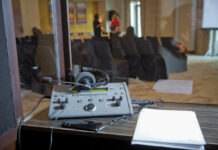Thanks to technological advancements and the creator, economy’s meteoric rise, producing high-quality audio is not only attainable — it’s become imperative. As billions of people consume content from their favorite online personas every minute, sounding as loud and clear as possible is not a mere whim. It’s crucial to engaging with the audience and connecting.
Having a great microphone at your disposal is essential for quality recordings, but it’s only the first step on a journey of trial, error, and discovery. What happens when you realize that your mic may sound great for your voice, but there are ones that sound even better — or more appropriate for what you are trying to convey? Unless space and money are no objects, you can’t possibly own each and every mic that interests you. To that, and other problems faced by experienced microphone users, there is a modern, exciting, and highly reliable solution — mic modeling.
Mic Modeling — The “How,” “What,” and “Why” Answered
In regards to microphones, the basic principles haven’t changed — microphones capture sounds as vibrations from the air and convert them to electrical signals which are amplified and can be recorded. The type of microphone you are using has a significant impact. Depending on their circuit design and purpose, microphones — especially studio models — have their own character, which shapes the tone of the recording.
For this reason, it is no coincidence that professional recording studios own (or rent) a wide range of microphones that can adapt to different voices and instruments. Unfortunately, not everyone can afford the expensive equipment used by professional studios. Vintage microphones, in particular, have become rare collector’s items with astronomical price tags. If that’s not prohibitive enough, maintaining a decades old microphone in working order is laborious, expensive, and time-consuming (at best) — or impossible (at worst), when original components are long out of production and lack substitutes.
This is where technology comes to the rescue in the form of microphone modeling systems. Instead of collecting vintage mics, you get to have their sound with the convenience of plug-ins and modern hardware. Your dream mic collection is right there on your computer, in digital form. Mic modeling technology has greatly matured over the last few years. The combination of advanced algorithms and high-quality reference microphones which color the sound very little (if at all) produces authentic recreations of classic, sought-after microphones. And it all happens at a fraction of their cost.
What Are the Advantages of Microphone Modeling?
Mic modeling systems can be affordable, versatile, highly reliable, and convenient.
Reasonable Costs
As a major advantage, we cannot fail to mention the affordability and easy availability of mic modeling compared to the often rare and expensive original hardware. Where a classic studio microphone can cost tens of thousands of dollars used, a brand-new USB microphone with built-in mic modeling — like the Antelope Audio Axino Synergy Core — plugs into your computer and is ready to go, for just USD 400!
High Quality and Reliability
In general, modern mic modeling systems are built from proven and reliable materials. You will not be required to do any unusual maintenance as long as you operate them correctly.
Incomparable Convenience
Have you ever been in a situation where you had to record with the one microphone you had instead of the one you knew you needed? This sounds quite unpleasant, and the results are often compromised. With a mic modeling system at your disposal, you can audition authentic-sounding virtual recreations of microphones you love — or never even knew existed. You can choose what feels right at the moment and switch it in production if you have a change of mind later. Most importantly, the availability of a certain microphone is no longer an obstacle to getting the desired results.
Types of Mic Modeling Systems
The most common type of mic modeling system comprises a reasonably neutral-sounding microphone of the large-diaphragm condenser type that’s most often used in recording studios. The uncolored signal it produces gets treated by digital microphone emulations running on your computer (or audio interface) during (or after) the recording. Typically, the microphone and software are sold in pairs, as the software is optimized for that specific microphone and using another will not yield the same results.
While this arrangement is quite convenient, technological progress has made it possible to simplify the setup even further. Antelope Audio, a pro audio manufacturer, came up with the first true “modeling microphones” — meaning the modeling software is built into the microphone itself, together with the preamp and everything else needed for recording. Just connect the Edge Go or Axino mic to your computer’s USB port and you are ready to begin.
Conclusion
As microphone modeling technology has advanced so much, its benefits have become too many to be overlooked. Moreover, the price of entry has become very reasonable considering how much value you get for the money. No matter which route you choose to go, hone those musical skills and keep plenty of inspiration. Regardless of the available technology, a great recording always starts with the source.
Find a Home-Based Business to Start-Up >>> Hundreds of Business Listings.

















































